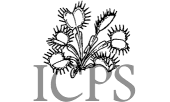|
Carnivorous Plant Newsletter
Volume 45, Number 2, June 2016, pages 73 - 78
New Cultivars
Cephalotus follicularis ‘Bananito’
Drosera ‘Anemone’
Drosera burmannii ‘Pilliga Red’
Drosera ‘Scarlet Tears’
Nepenthes ‘Autumn Wine’
Sarracenia ‘Ares’
Sarracenia ‘Ares’
Submitted: 18 February 2016
Sarracenia ‘Ares’ is a lost label cultivar from the early years of my breeding efforts. Over the past twenty years it has proven to be vigorous and dependable — my first really good red Sarracenia hybrid (Fig. 1 & Back Cover). The pitchers erupt over a short period early in the growing season and are generously produced. The near uniform red color, for me, is deeper in warmer and brighter weather. The color holds until senescence and may even deepen with age. The pitchers are erect through the growing season. The rhizomes branch regularly making a plant that fills a pot nicely.
For me here in Washington state Sarracenia ‘Ares’ plants typically grow 50 to 60 cm tall pitchers and produce hoods that reach 9 to 13 cm across. The plant’s flower starts out pink towards the center and grades to a creamy white suffused with pink towards the ends (Fig. 1).
Sarracenia ‘Ares’ is named for the god of war and its echoes. His bloody work in its ruddy coloration.
To maintain these memorable characteristics, this plant should be reproduced only by vegetative means.
— Jerry Addington • Courting Frogs Nursery • Stanwood • Washington • USA • jerry@courtingfrogs.com
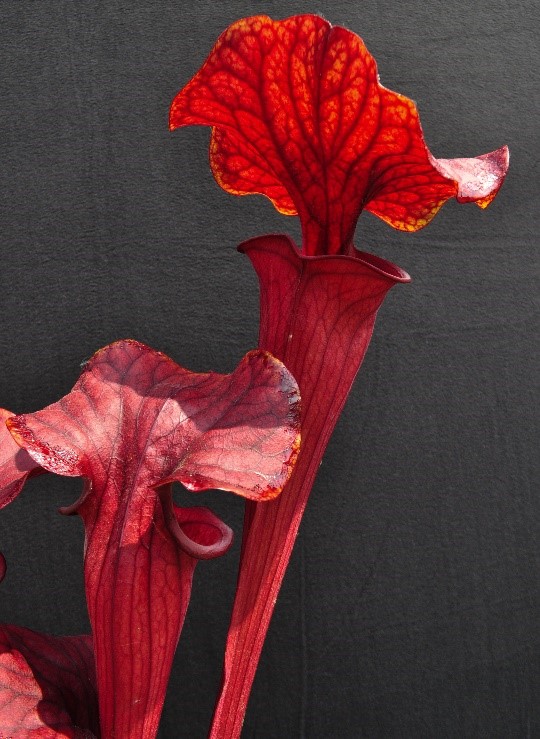 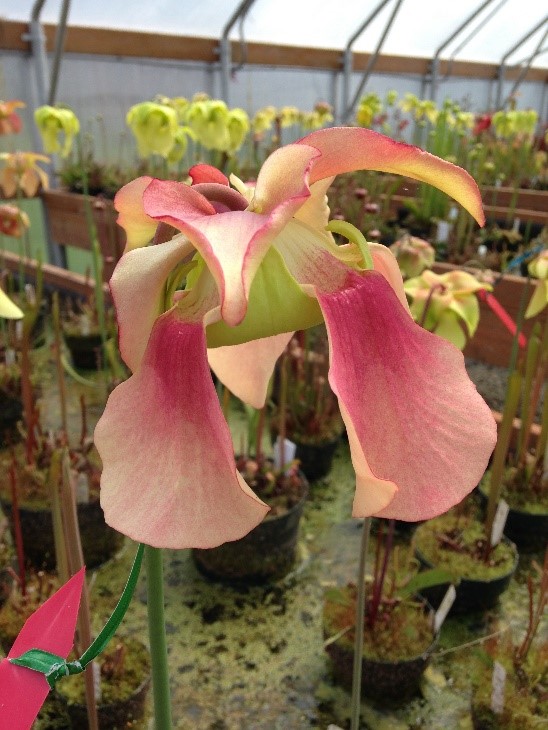
Figure 1: Sarracenia ‘Ares’ pitchers (left) and flower (right).
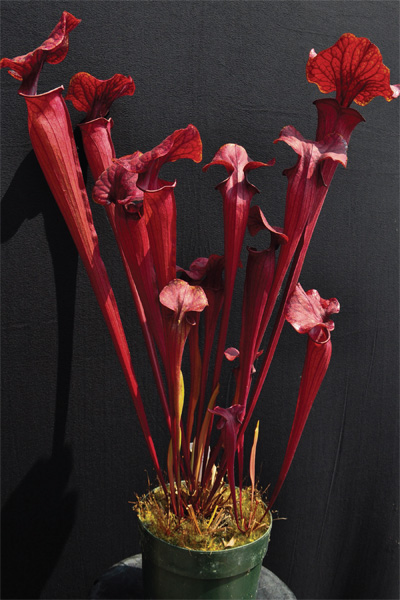
Back Cover: Sarracenia ‘Ares’ mature plant. Photo by Jerry Addington.
Drosera ‘Anemone’
Submitted: 24 December 2015
This plant was produced in late 2014 by crossing a specimen of Drosera sp. Lantau Island (thought to be a fertile hybrid of Drosera oblanceolata × spatulata) with D. capensis ‘Albino’, resulting in a stout rosetted plant bearing semi-erect elongate leaves intermediate between the paddle-shaped leaves of the mother and the strap leaves of the father, and was the only seed to successfully sprout. The plant can reach, possibly exceed, 76 mm across, and leaves up to 5 mm off the ground. Even in full sun the leaves retain a greenish to slightly yellowish ground color, blushing on the edges and in the tentacles with scarlet (Fig. 2). Flower stalks can be incredibly tall, upwards of 46 cm or more with blooms 2 cm wide and a delicate pale pink shade (Fig. 3).
The name originates from the appearance of the outstretched leaves, extending in all directions greedily like the stinging tentacles of sea anemones, and adorned with attractive bright colors to match. This is a sterile hybrid, capable of being propagated only by vegetative means such as leaf or root cuttings.
— Hawken Carlton • Greeley • Colorado 80634 • USA • hawken.carlton5@gmail.com
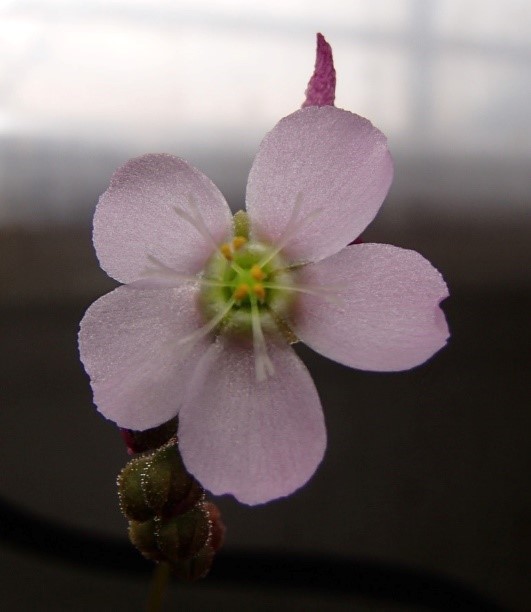
Figure 2: Drosera ‘Anemone’ flower.
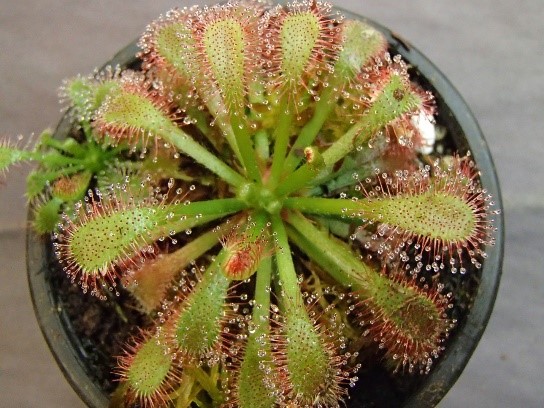 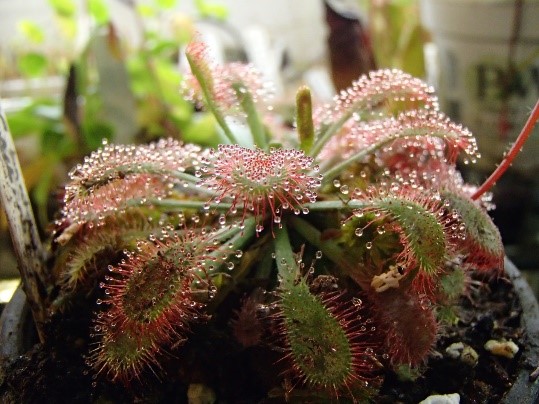
Figure 3: Drosera ‘Anemone’ top and side views.
Drosera ‘Scarlet Tears’
Submitted: 3 January 2016
Drosera ‘Scarlet Tears’ (Fig. 4) is a beautiful plant with a complex background. In early 2015, a specimen of Drosera anglica from the Alakai Swamp locality of Hawaii was crossed with a horticulturally made D. spatulata hybrid between the cultivar D. ‘Tamlin’ and a pink-flowered locality plant from Royal National Park in Sydney, Australia. This breeding produced a batch of seedlings that are fully subtropical in nature and relatively large, with variable specimens bearing both pink and white flowers and ranging from relatively green to bright red leaves.
From this batch, a single pink-flowered specimen was selected for its larger size and rich color. The rosette can reach up to 8 cm across, the semi-erect leaves stretching upward as they first grow out to a height of 3 cm before falling toward the soil. When the leaves first unfurl they are a rich olive green with scarlet tentacles, infusing rapidly with color to become fully scarlet or burgundy. The short flower stalks to 16 cm will bear small, 1 cm pink blooms.
The name, coined by my sister Holly, reflects the aged red color and the appearance of the leaves, the lamina on the tip of the narrow petiole is like a rounded tear that rolls down one’s face, stretching itself and leaving a thin stain behind as it travels.
As this is a sterile hybrid and a unique clone among dozens of siblings, this cultivar is suitable only for vegetative reproduction. Scape/peduncle, leaf, and root cuttings will all strike quickly.
— Hawken Carlton • Greeley • Colorado 80634 • USA • hawken.carlton5@gmail.com
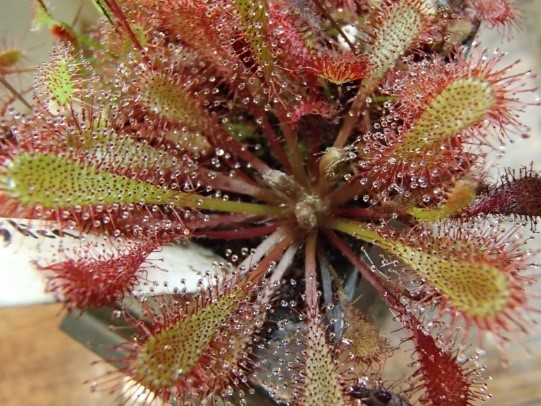 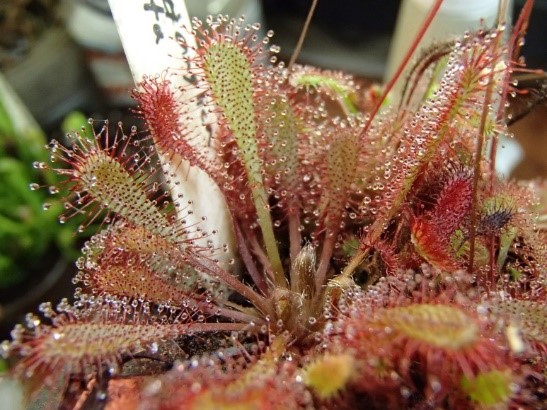
Figure 4: Drosera ‘Scarlet Tears’ top and side views, portraying the semi-erect rosette nature and reddened hue of the plant.
Nepenthes ‘Autumn Wine’
Submitted: 24 December 2015
Received as a seed-grown plant from Tony Paroubek in late 2013, this plant has proven to be a vigorous grower and tolerant of a wide range of temperatures. It is a result of the cross Nepenthes “Viking” (mirabilis var. globosa) #19 × (maxima × trusmadiensis) and displays much of the shape of the female parent along with coloration and pitcher details of the male.
Leaves can exceed 40 cm long, semi-oblong with a tapering tip, a very slightly peltate tendril attachment on most and with a slight tendency to blush red under strong light. Upper pitchers can reach over 18 cm long and unlike lowers have only a pair of ridges in place of the wings. They are roughly infundibular with a very slight bulge approximately halfway down the pitcher, giving the profile a faint hourglass shape like a fancy wine goblet (Fig. 5). Upper pitchers typically have a larger, flared peristome compared to lowers, and while in lower pitchers the peristome may wrap around the lip of the pitcher it will often stay open and nearly flat in uppers. The lower pitchers can reach over 13 cm tall and up to 8 cm wide, roughly cylindrical in shape throughout with a slight bulge below the mouth and bearing distinct rigid wings (Fig. 6). The peristome is wide, with small but distinct ridges and the smallest of teeth along the inside edge, and the lid is roughly ovular and bears numerous obvious nectar glands on the underside. Both lowers and uppers may be covered in a very thin indumentum, visible in bright light on the sides of the pitcher and tendrils.
This plant is named after its notable coloration, the body of the pitchers infused from opening with a rich maroon red like that of an expensive red wine that deepens with age, lower pitchers sometimes reaching a state of almost black cherry coloration. Faint, darker blotches are also present like stains of wine on an old tablecloth. The peristome is heavily striped in varying shades of yellow, orange and red, like the colors of autumn leaves, infusing as it ages with the same wine-red coloration of the pitcher body, the stripes staying evident as they darken in turn.
Having yet to flower, the sex of this plant is unknown. To maintain the special characteristics of this cultivar it can only be propagated by vegetative means such as cuttings of the stem or basal shoots.
— Hawken Carlton • Greeley • Colorado 80634 • USA • hawken.carlton5@gmail.com
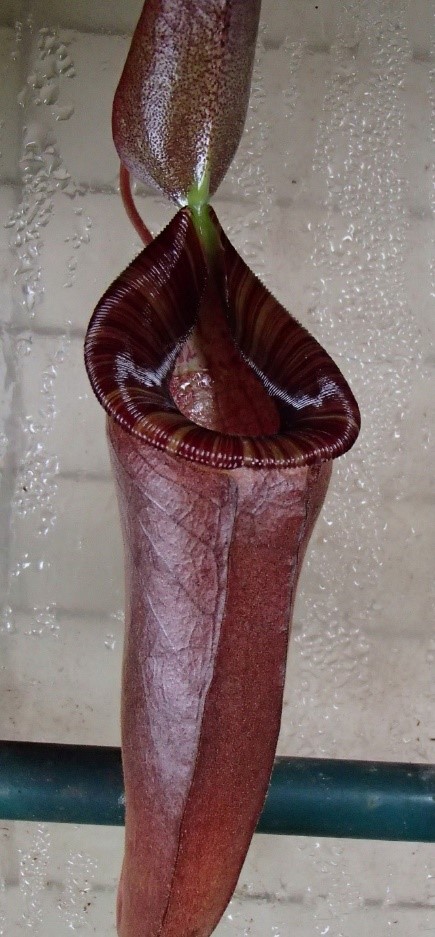
Figure 5. Upper pitcher of Nepenthes ‘Autumn Wine’ showing the faint hourglass shape and wide peristome.
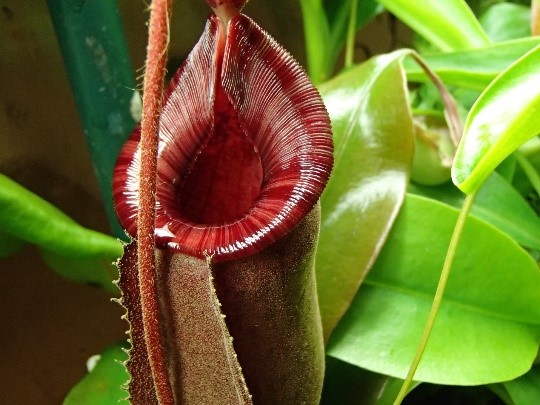 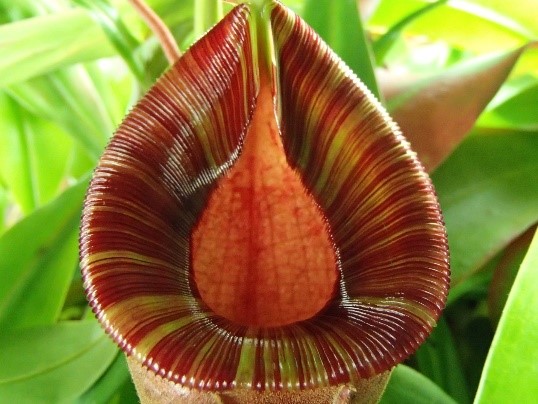
Figure 6. Typical lower pitcher of Nepenthes ‘Autumn Wine’, showing the deep wine coloration and faint “stain” blotches on the pitcher body as well as the thin indumentum (left) and peristome detail (right). Distinct ridges and heavy striping are present on all pitchers, stripes staying visible even in dark, aged peristomes.
Cephalotus follicularis ‘Bananito’
Submitted: 11 April 2016
In 2012, I received four plants produced from seeds of Cephalotus ‘Eden Black’ selfed. In general,
Cephalotus follicularis plants are very similar to each other, but one of these plants produced
an unmistakable elongated shape, like a banana (Fig. 7). On 3 April 2014, I named this plant Cephalotus
follicularis ‘Bananito’. The name “Bananito” is Italian for “small banana”.
This plant is very vigorous. The pitchers have maintained their characteristic shape while being
grown both indoor and outside. To preserve the unique characteristic of the cultivar, reproduction
should be by vegetative means only.
—Erio Piacenti • 40129 Bologna • Italy • eriomix@alice.it
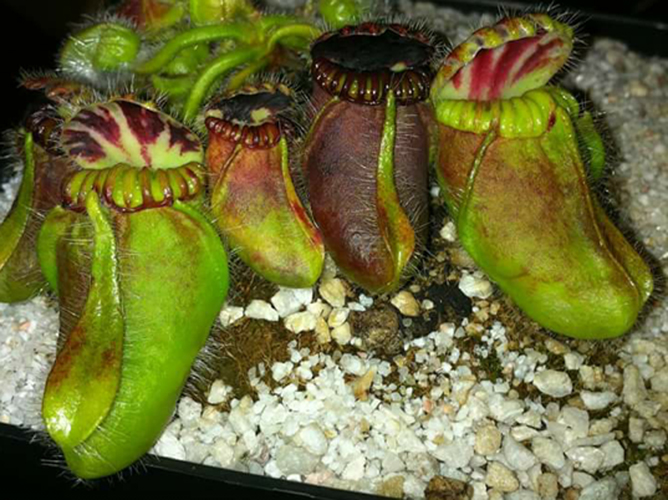
Figure 7: Cephalotus follicularis ‘Bananito’ with the characteristic elongated banana-like
shape.
Drosera burmannii ‘Pilliga Red’
Submitted: 28 March 2016
In the late 1990s when I lived in Dubbo in inland New South Wales I found several populations
of Drosera burmannii Vahl. in the local region. Most of the local plants comprised plants with green
to red rosettes, but they all had white-petalled flowers. However, two of those populations contained
plants that developed red-leaved rosettes and had flowers with pink-petals (Fig. 8). Plants grown from seed from the northern population also developed red leaves and had pink flowers. They began
to enter cultivation under the informal name of “Pilliga Red” – a name suggested during correspondence
with Ivan Snyder. I propose to formally name such plants as Drosera burmannii ‘Pilliga Red’.
This cultivar is named after the Pilliga State Forest in inland north eastern NSW, Australia. The
largest population of these heavily pigmented plants occur in this state forest on the southern shore
of an ephemeral lake about 37 km south of Narrabri. The second population I found is 12 km northeast
of Dubbo. This cultivar name applies to plants with the same pigmentation pattern from those
populations and other populations elsewhere in the region. As with other plants of D. burmannii,
flowers of D. burmannii ‘Pilliga Red’ open only for a few hours in the morning.
—Robert Gibson • Cardiff Heights • NSW 2285 • Australia • robert.gibson@environment.nsw.gov.au
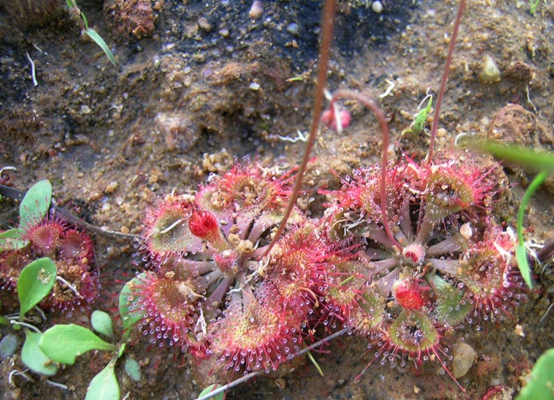 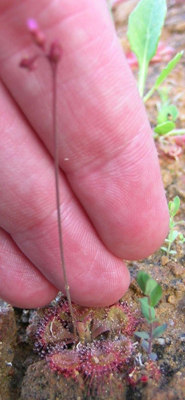
Figure 8: Red rosettes of Drosera burmannii ‘Pilliga Red’ south of Narrabri and in scape. Note the pink petals on the recently-closed flower.
|
